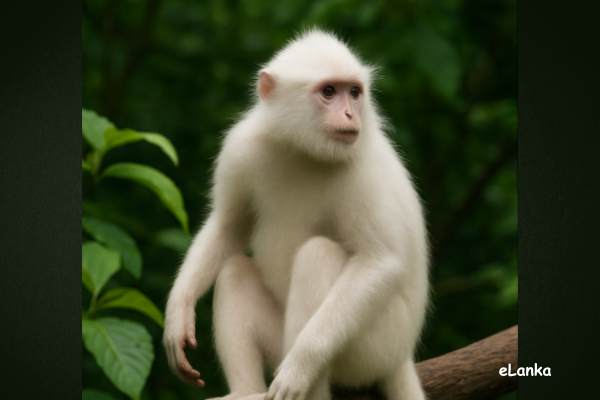Mystical White Monkeys of Sinharaja: A Rare Sight Enchanting Visitors – By Nadeeka – eLanka

Deep in the lush rainforests of southern Sri Lanka, a rare and captivating sight has been drawing curious travelers and wildlife enthusiasts to the remote village of Lankagama—snow-white monkeys with ghostly coats and an air of mystery. These unusual primates, discovered near the Sinharaja Forest Reserve, are a striking color variation of the purple-faced langur, an endangered species found only on the island.
A Genetic Rarity: Not Quite Albino
Unlike typical purple-faced langurs that sport black fur and distinctive white sideburns, these “white” langurs exhibit either completely pale coats or partially white patches. Scientists have identified this condition as leucism, a genetic trait that results in reduced pigmentation across all fur and skin, rather than albinism, which only affects melanin production.
The white langurs have mostly been observed among populations of the southern subspecies (Semnopithecus vetulus vetulus) of the purple-faced langur, especially in areas surrounding Lankagama, a lesser-known entry point to the Sinharaja Forest.
Folklore and Fascination
While the scientific community has only recently begun to document these monkeys in detail, local villagers have long been familiar with their ghostly presence. For generations, stories of pale monkeys wandering the forest have been part of Sinharaja’s folklore, often regarded as omens—both good and bad.
In recent years, sightings have increased, and nature organizations have begun tracking these rare primates. A 2011 field study by the Wildlife Conservation Society of Galle (WCSG) documented dozens of leucistic individuals among local monkey troops, further confirming their presence.
Lankagama’s Tourism Boom
Tourism in Lankagama is thriving thanks to this natural wonder. While most visitors have traditionally entered Sinharaja through the main village of Kudawa, many now opt for the Lankagama route in hopes of spotting the elusive white monkeys.
This shift has created economic opportunities for the local community, from eco-lodges to guided treks focused on primate viewing. Much like Canada’s spirit bears or South Africa’s white lions, Sri Lanka’s snow-white langurs have begun to build a reputation as a natural symbol of rarity and wonder.
Conservation Through Curiosity
At a time when monkeys are often viewed as agricultural pests in Sri Lanka—especially the toque macaques known for raiding crops—this renewed interest in langurs offers a refreshing perspective. It highlights the importance of biodiversity, eco-tourism, and wildlife protection as intertwined pillars of sustainable development.
Sri Lanka is home to three species of monkeys: the toque macaque (Macaca sinica), gray langur (Semnopithecus priam), and purple-faced langur (Semnopithecus vetulus). Interestingly, albino individuals have also been reported among the toque macaques and gray langurs, adding to the island’s repertoire of rare wildlife phenomena.
A Glimpse Into the Extraordinary
As word spreads about the white monkeys of Sinharaja, Lankagama finds itself on the global map of wildlife tourism. These creatures—once the subject of whispered legends—are now ambassadors of Sri Lanka’s natural beauty, offering a rare glimpse into the wild’s most extraordinary surprises.






















